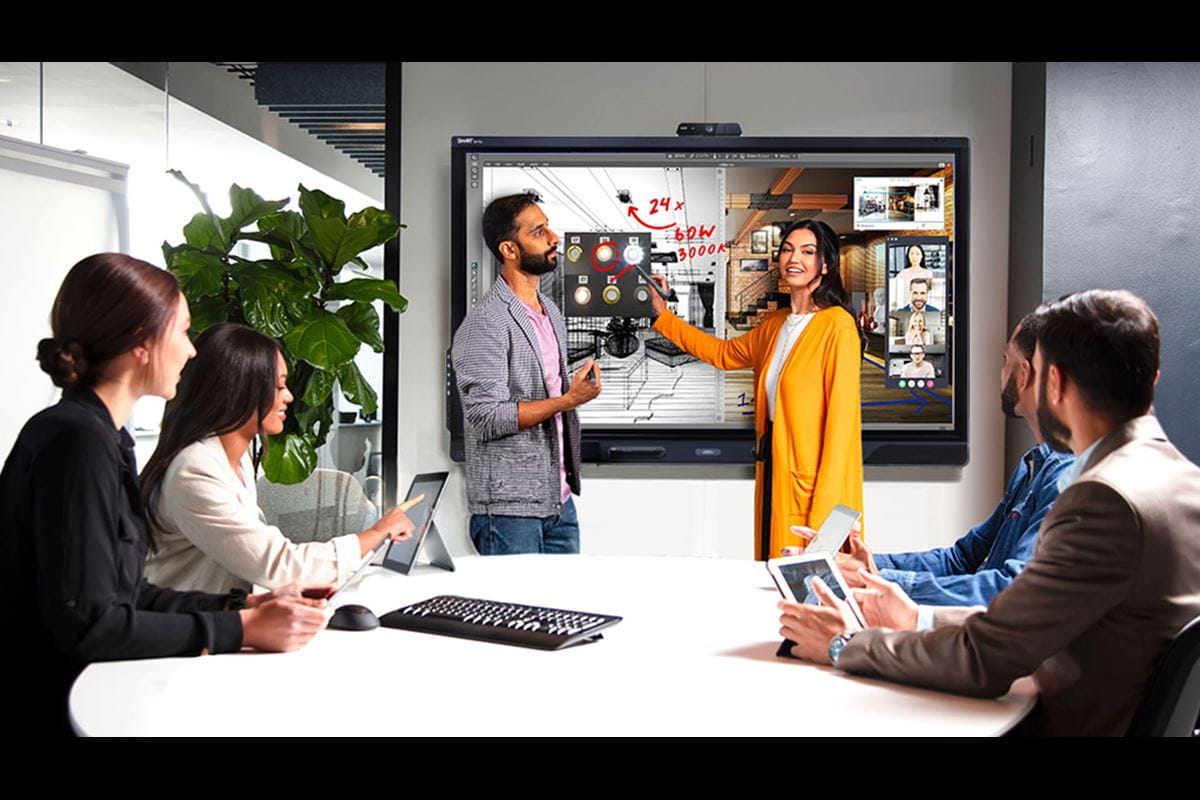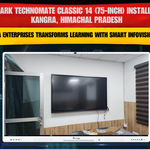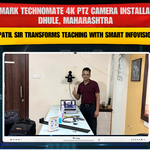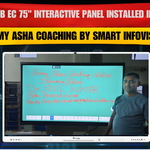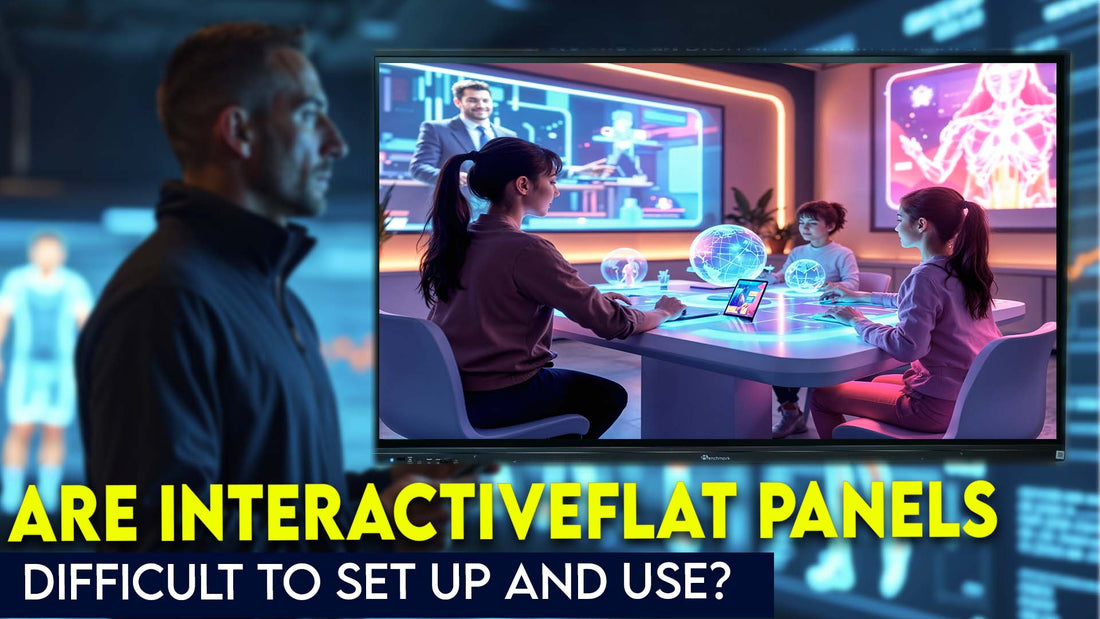
- Classroom Digital Board
- Classroom Solutions
- Classroom Tech
- Digital Board Features
- Digital Boards for
- Digital Education
- Digital Learning
- E-Learning Tools
- EdTech Innovation
- Educational Technology
- Interactive Boards
- Online Classroom Engagement
- Online Learning Tools
- Online Teaching
- Remote Education
- Smart Classroom
- Smart Education
- Teaching Online
- Teaching Tools
- Tech in Education
- Virtual Classroom
- Virtual Learning
Are Interactive Flat Panels Difficult to Set Up and Use?
21 October 2024
Interactive Flat Panels (IFPs) are revolutionizing the way classrooms, offices, and collaborative spaces operate. These high-tech displays combine the functionality of a traditional whiteboard with the capabilities of modern touchscreens, offering users interactive tools, real-time collaboration features, and seamless connectivity options. But a common concern among users, especially first-timers, is: Are Interactive Flat Panels difficult to set up and use?
In this detailed blog, we’ll demystify the setup process and highlight just how easy it is to integrate IFPs into your workspace or learning environment. Whether you are a school administrator or a business owner looking to upgrade your equipment, this guide will walk you through the installation, setup, and practical usage of interactive flat panels.
What is an Interactive Flat Panel?
An Interactive Flat Panel is a touchscreen display designed to foster collaboration and engagement. These devices combine high-resolution screens with built-in computing power and interactive software, allowing users to draw, annotate, and share content in real-time. Thanks to wireless connectivity and cloud integration, they make learning and working more interactive and effective.
IFPs are becoming increasingly popular in education, corporate meetings, training sessions, and even teleconferencing, offering features like multi-touch support, whiteboard tools, and real-time screen sharing.
Also Read: Key Features to Consider When Buying a Classroom Digital Board

Are Interactive Flat Panels Difficult to Set Up?
The answer is no—interactive flat panels are surprisingly easy to set up. Most models are designed with user-friendliness in mind, ensuring that even individuals with minimal technical knowledge can install and operate them without hassle. Here’s a step-by-step guide on how to set up an Interactive Flat Panel efficiently.
1. Unboxing and Mounting the Panel
- Begin by carefully unboxing the Interactive Flat Panel and checking that all accessories (like power cables, remote controls, and mounting brackets) are present.
- Depending on your space, you can either mount the panel on the wall or place it on a mobile stand. Most IFPs come with VESA-compatible mounts, making wall installation straightforward.
- If you choose a stand, simply follow the assembly instructions provided. Mobile stands offer added flexibility since you can move the panel across different rooms.
2. Connecting Power and Peripherals
- Plug the panel into a power outlet and switch it on.
- You can connect additional devices, such as computers, laptops, USB drives, or cameras, via HDMI, USB, or VGA ports. Many modern IFPs also support wireless screen mirroring, allowing seamless content sharing from laptops and smartphones.
3. Setting Up the Software and Network Configuration
- Most Interactive Flat Panels come with pre-installed software like digital whiteboards, screen annotation tools, or interactive lesson planners.
- Connect the panel to your Wi-Fi network to access cloud-based features and software updates. Some panels offer network settings wizards, making this step easy even for non-technical users.
Also Read: Social Media Strategies for Studio Owners: Building an Online Presence
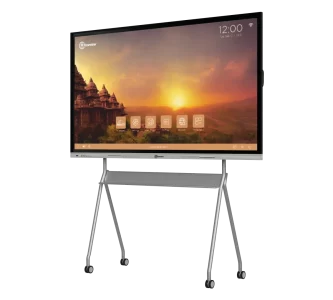
Is Using an Interactive Flat Panel Complicated?
Once installed, using an Interactive Flat Panel is as easy as using a tablet or smartphone. These panels are built to be intuitive, with touchscreen controls and easy navigation menus. Here are some features that make them simple to use:
1. Multi-Touch Gestures and Intuitive Interface
IFPs support multi-touch gestures like pinch-to-zoom, swipe, and drag, making interactions feel natural. Whether you’re scrolling through presentations or annotating documents, the interface is designed to feel familiar.
2. Seamless Wireless Sharing
IFPs allow wireless sharing from devices like laptops, smartphones, and tablets, removing the hassle of messy cables. With just a few taps, you can mirror your device’s screen on the panel and present content in real-time.
3. Pre-Installed Apps and Software Integration
Modern Interactive Flat Panels come with pre-installed apps like Microsoft Office, Google Meet, Zoom, and more. This makes it easy for users to access the tools they use daily without additional setup. Some panels also integrate with cloud platforms like Google Drive, allowing users to pull documents directly from the cloud.
4. Remote Management and Training
IFPs are equipped with remote management options that allow IT teams to control and update multiple panels from a central location. Many manufacturers also offer tutorial videos and online support to help users master the features.
Also Read: Building an Online Presence for Your Studio: A Comprehensive Guide
Benefits of Interactive Flat Panels in Classrooms and Workplaces
1. Enhanced Collaboration
Interactive Flat Panels provide a collaborative environment where users can draw, annotate, and share ideas in real-time. This improves both classroom engagement and team productivity during meetings.
2. Ease of Access and Flexibility
Whether in a remote work setup or a physical classroom, IFPs provide flexibility. Users can join meetings from anywhere or access learning materials at their convenience. With remote access tools, teachers and team leaders can control the IFP even when not physically present.
3. Paperless Learning and Presentations
By eliminating the need for physical whiteboards, markers, or printed handouts, Interactive Flat Panels promote eco-friendly learning and working environments. All notes and presentations can be saved digitally and shared instantly.
4. Easy Troubleshooting and Updates
IFPs usually feature over-the-air (OTA) software updates, meaning users don’t need to install updates manually. Troubleshooting is also easy with built-in self-diagnostic tools and 24/7 customer support provided by many manufacturers.
Overcoming Common Setup Challenges
While setting up Interactive Flat Panels is straightforward, users may encounter some minor challenges. Here’s how to overcome them:
1. Internet Connectivity Issues
Sometimes, network configurations may require additional setup. If you encounter issues, ensure your router settings are correct and check if the panel’s firmware needs updating.
2. Calibration Adjustments
Some models may require touchscreen calibration during the initial setup to ensure accurate input. The good news is that most IFPs provide step-by-step calibration wizards for easy adjustments.
3. Compatibility with External Devices
If you experience difficulty connecting external devices, check whether the necessary drivers are installed or if the IFP model requires specific adapter cables.
FAQs: Interactive Flat Panels Setup and Usage
Are Interactive Flat Panels suitable for non-technical users?
Yes, Interactive Flat Panels are designed with user-friendliness in mind. The interfaces are intuitive, and most panels come with easy-to-follow setup instructions. Additionally, online tutorials and technical support are available to help users of all skill levels.
Do Interactive Flat Panels require professional installation?
While professional installation is available, it’s not always necessary. Many users can install the panels themselves using VESA-compatible mounts and simple assembly instructions. Mobile stands also provide an easy alternative to wall mounting.
Can Interactive Flat Panels connect to multiple devices simultaneously?
Yes, modern IFPs support multiple device connections through HDMI, USB, and wireless mirroring. This allows users to switch between presentations, videos, or documents easily during meetings or lessons.
What happens if the panel encounters a technical issue?
Most IFPs feature built-in diagnostic tools that help troubleshoot common issues. In case of more complex problems, manufacturers typically offer customer support and warranty services.
Are software updates automatic on Interactive Flat Panels?
Yes, most panels support automatic over-the-air (OTA) updates, ensuring the latest software is always installed without manual intervention.
How long does it take to set up an Interactive Flat Panel?
The setup process typically takes 30-60 minutes, depending on the installation type (wall-mounted vs. mobile stand). Additional time may be required for software configuration and network settings.
Conclusion
Interactive Flat Panels are easy to set up and use, making them an excellent choice for classrooms, offices, and training environments. From wireless sharing to intuitive multi-touch gestures, these panels offer a user-friendly experience that enhances collaboration and productivity. Whether you’re a school administrator, business leader, or IT manager, investing in an Interactive Flat Panel will simplify your operations and create more engaging learning or working environments.
With easy installation and built-in features designed for non-technical users, Interactive Flat Panels are truly transformative tools that anyone can operate with confidence.
Prev post

10 Reasons Why an Interactive Flat Panel Display is Essential for Modern Classrooms and Meetings
Updated on 22 October 2024
Next post

How an Interactive Digital Board Transforms Learning and Collaboration
Updated on 20 October 2024
You Also Like
Benchmark Technomate Sigma 75 Installation in Maharashtra | Smart Infovision Leads the Digital Classroom Revolution
- 4k smart display
- Benchmark Technomate 75-inch
- Benchmark Technomate Installation Maharashtra
- Benchmark Technomate Sigma 75
- Benchmark Technomate Sigma Series
- classroom digital transformation
- Digital Education Transformation India
- digital learning setup
- Digital Learning Solutions India
- Education Technology Maharashtra
- Interactive Display Installation India
- professional installation smart infovision
- sigma series interactive panel
- Smart Board for Classrooms
- smart classroom installation
- Smart Classroom Setup Maharashtra
- smart education india
- Smart Infovision A Name of Trust
- smart infovision installations
- Smart Infovision Installations India
- smart infovision maharashtra
- Smart Infovision Pvt Ltd
- Smart Learning Solutions
- technology in education
- training setup maharashtra
Benchmark Technomate MaxPro Ultra 14 (75-inch) Installation at Fusion Homes, Greater Noida (West) | Smart Infovision – A Name of Trust
- Benchmark Technomate MaxPro Ultra 14
- Benchmark Technomate Projects
- Benchmark Technomate Series
- Corporate Smart Board
- Digital Learning Solutions
- Digital Transformation India
- Home Office Smart Setup
- Interactive Digital Panel
- Interactive Flat Panel India
- Smart Board Installation in Greater Noida
- Smart Classroom Setup India
- Smart Display 75 inch
- Smart Education Setup
- Smart Infovision
- Smart Infovision Blog
- Smart Infovision Installations
- Smart Infovision Pvt Ltd
- Technology Installation Stories
Maxhub EC 75" Interactive Panel Installed in Patna | Army Asha Coaching by Smart Infovision
- army asha coaching centre patna
- coaching centre digital setup
- digital board for coaching
- interactive flat panel patna
- maxhub dealer in bihar
- maxhub ec 75
- maxhub ec 75-inch
- maxhub ec series india
- maxhub installation in patna
- maxhub interactive panel
- maxhub patna
- modern classroom setup
- smart classroom installation patna
- smart classroom setup bihar
- smart infovision digital education
- smart infovision installation
- smart infovision pvt ltd
- smart learning india

